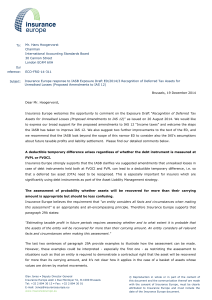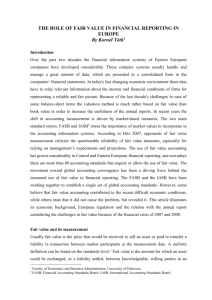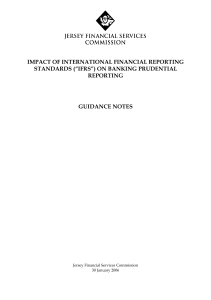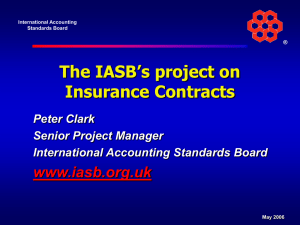AAA IASB Ins. Acctg - Casualty Actuarial Society
advertisement
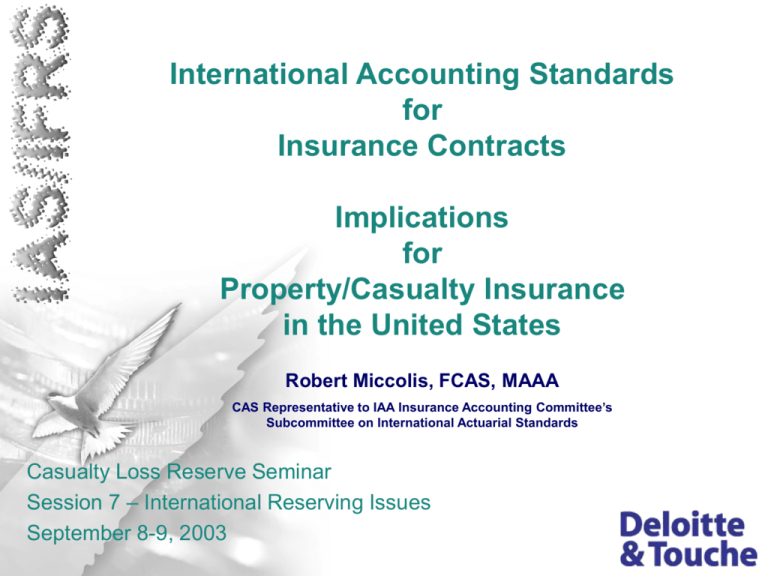
International Accounting Standards for Insurance Contracts Implications for Property/Casualty Insurance in the United States Robert Miccolis, FCAS, MAAA CAS Representative to IAA Insurance Accounting Committee’s Subcommittee on International Actuarial Standards Casualty Loss Reserve Seminar Session 7 – International Reserving Issues September 8-9, 2003 Questions What is the IASB? (International Accounting Standards Board) What is an IFRS? (International Financial Reporting Standard) What is an IAS? (International Accounting Standard) Why is this important? What is the role of the FASB? Will US GAAP change? What will happen to regulatory STAT? What impact will this have on US actuarial work? When does this all happen? IASB The body that sets accounting standards for all companies permitted or required to follow its standards The European Community, as agreed by the EU Parliament, will require all “listed” companies in the EC to adhere to accounting standards set by the IASB starting in 2005. A few countries currently are using IAS as their local accounting standard (with exceptions) IAS & IFRS Currently, standards promulgated by the IASB are designated as an IAS, for example IAS 39. IRFS will become the new designation, as a better description of what these standards are to be used for, i.e., financial reporting. Current IAS designations have not been changed. IAS 39 has had the most attention for insurance. It’s application has excluded “insurance” contracts, but the IASB has proposed a more precise definition of an insurance contract vs. a “financial instrument” (or investment contract) which would be valued differently than currently allowed for insurance contracts. IAS 39 The main concern about IAS 39 is that it requires contracts (assets and liabilities) to be valued at market In the absence of a market value, fair value is to be used, based on a valuation using appropriate methods Many life & annuity insurance contracts contain both pure insurance and investment (“financial”) components Some P/C contracts, e.g. financial/finite reinsurance, can also have both components Accounting for Insurance Contracts The IASB has been working on many aspects of reconciling accounting differences and advancing a consistent approach across industries The IASB Insurance Project was started over 2 years ago with the issuance of a DSOP – Draft Statement of Principles regarding accounting for insurance contracts Notice that the focus is specifically on insurance contracts and not on insurance companies Why is an insurance standard required? Insurance contracts are now excluded from most IFRS Globally no common insurance accounting practice and the differences are material There are many features unique to insurance, for example, the discretion that management have in designing some contracts History and Looking Forward 1997 Steering committee set up by the IASC 1999 Issues paper 2001 DSOP developed as precursor to Exposure Draft May 2002 Project splits into 2 Phases Phase 1 Exposure Draft issued July 31, 2003 Final Phase 1 standard issued in 2004 for 2005 financials Fair Value “disclosures” in year end 2006 financials Phase 2 implementation by 2007 (sunset) Revised IASB Insurance Proposals: The Two Phase Approach Phase 1 - interim solution - quick fixes to be in place by 2005 • common definition of insurance • limited and temporary dispensation from existing IFRS • guidance on IAS 39 • significant disclosures required Phase 2 – a standard covering recognition and measurement issues for insurance contracts, including fair value Phase 1 – Insurance Contracts Phase 1 is expected to result in a new standard which will: Introduce a common definition of insurance across all standards; Include guidance on the implementation of IAS 32 and 39 for insurance; Specify disclosures required for insurance (very significant); Avoid the need for implementing major changes to accounting systems for insurance contracts prior to completion of phase 2. This involves a temporary dispensation from certain existing IFRS. The timetable for Phase 1: 31 July 2003 exposure draft - comments due 31 Oct 2003 and, a standard published in the first half of 2004. Phase 1 Dispensation from IAS/IFRS IAS 8 – Covers what to do when there is no Accounting Standard Dispensation from IAS 8 for Insurance Contracts to allow the use of local GAAP, and including: • Deferred acquisition costs • Unearned premium reserves (pro rata basis) • Embedded value measurement Allow companies to adopt accounting changes, but only if the change is more relevant and reliable (closer to fair value) Phase 1 Dispensation from IAS/IFRS No further dispensation for insurers • e.g. from the requirements of IFRS 39 for contracts that do not meet the definition of insurance Why allow dispensation? • Avoids major changes to accounting systems prior to final standard on insurance (in phase 2) • Allows investors familiar with embedded values (DAC, UPR, etc.) to continue to rely on them IASB New Definition of Insurance Contract The Phase I proposes a definition of an insurance contract as: “a contract under which one party (the insurer) accepts significant insurance risk by agreeing with another party (the policyholder) to compensate the policyholder or other beneficiary if a specified uncertain future event (the insured event) adversely affects the policyholder or other beneficiary” (other than an event that is only a change in one or more of a specified interest rate, security price, commodity price, foreign exchange rate, index of prices or rates, a credit rating or credit index or similar other variable). A reinsurance contract is defined as: “an insurance contract issued by one insurer (the reinsurer) to indemnify another insurer (the cedant) against losses on an insurance contract issued by the cedant” Common Definition of Insurance The definition is required for identifying: • Which insurance products fall within existing standards (IAS), for example, IAS 39 - those products that are more akin to savings than protection (investment risk as opposed to insurance risk) • The scope of temporary dispensation in Phase 1 Guidance on the Definition of Insurance The meaning of “significant” insurance risk • If, and only if, it is plausible that an insured event will cause a significant change in present value of insurer’s net cash flows • Even if the insured event is extremely unlikely • Even if the contingent cash flows (for insured events) is a small proportion of the expected (probability-wtd) PV of all cash flows • However, there needs to be a plausible scenario that produces a non-trivial change in the PV of contract cash flows For most property/casualty insurance contracts, there should not be an issue regarding this definition. • Lack of risk transfer would be problem (not just reinsurance) What is included in Phase 1? Financial contracts written as “insurance” (or reinsurance) IAS 39 applies to insurance products failing definition of insurance but exposed to financial risk (not insurance or financial, then service contract) Changes to the valuation of “insurance” contracts are excluded from Phase 1 Ceded reinsurance – must be reported as an asset • Insurance Liabilities – Direct plus Assumed • Assets – include All Ceded Reinsurance Recoverables • Prepare for Phase 2 – Fair Value measurement Phase 2 – Insurance Contracts Phase 2 will then lead to a comprehensive standard on the recognition and measurement for insurance contracts. This standard would replace temporary dispensations and the Phase 1 interim accounting standards. This final Phase 2 standard is expected to be published in time for full implementation by 2007. (Exposure Draft planned for 2004.) Phase 2 decisions Phase 2 to be developed upon these principles: • Definition of insurance – no change from phase 1 • Asset & Liability approach rather than Deferral and Matching • Deferral and Matching is replaced – UPR no longer a liability (replace with unexpired risk reserve) – DAC no longer an asset • Fair Value measurement – Independent valuation of Assets vs. Liabilities – Profit “at inception” likely to be no greater than zero Impact on US P/C Companies Pressure from financial regulators (SEC) and financial markets for a common global financial accounting reporting standards Commitment of FASB and other accounting bodies for “convergence” of accounting standards Europe & Australia will be first, then others (US) will follow due to global business and financial markets Time to comment on technical issues is right now Changes to P/C Actuarial Practice Fair Value will be difficult to avoid Impact on US P/C actuarial practice will depend on • • • • • • FASB view of timing to converge with IASB FASB plans relative to IASB exposure drafts and standards Views of Insurance Regulators on avoiding 2+ sets of books US based insurers with European parents US based insurers with significant European operations US listed insurers who are also listed on EU exchanges Principles and standards have to be developed now • Fair Value Issues papers by CAS, AAA and GIRO (2002) • CAS proposes research on fair value measurement (Sept. 2003) Highlights of Fair Value (Phase II) Discounting of P/C Liabilities • Reserves for unpaid loss and loss adjustment expenses • Reserves for unexpired risks (UPR) Market Value Margins – added to discounted liabilities • • • • Reflects risk and uncertainty in reserves Reflects “market” price (margin) for reserve risk Reflects “mark-up” for transaction cost of selling reserves Own credit risk adjustment (controversial) Own Credit Risk • Reduction in liabilities based on credit standing • Offset by any government guarantees or legal preferences More information is available on www.IASplus.com www.IASB.org.uk

